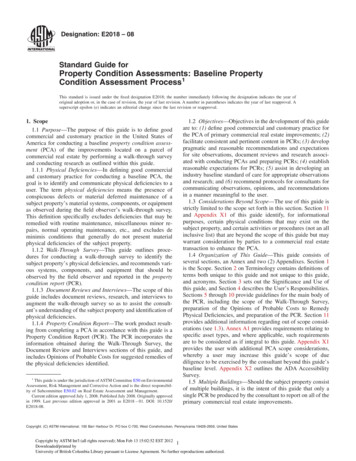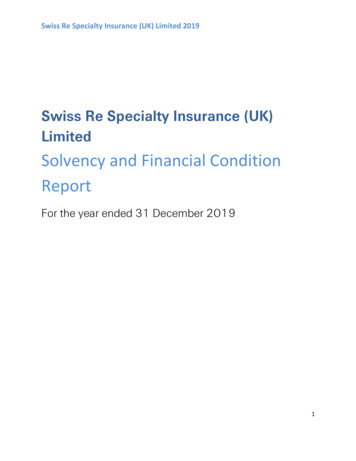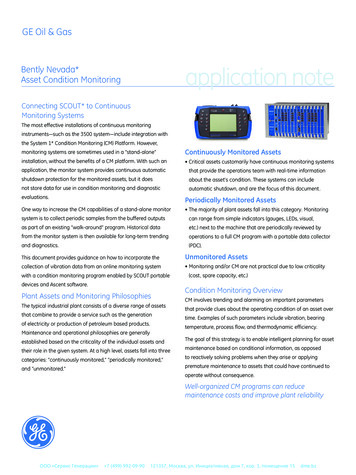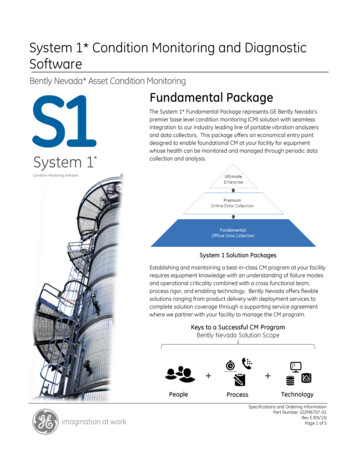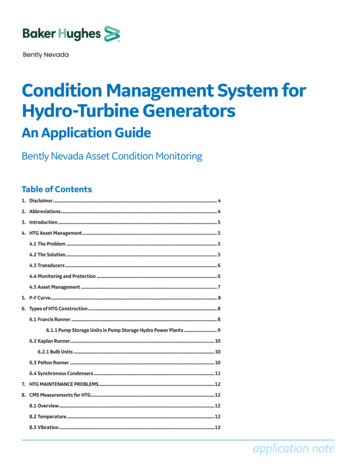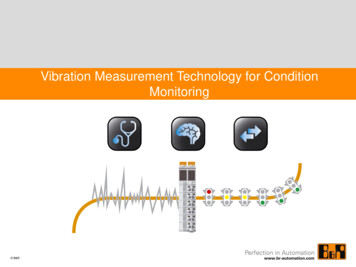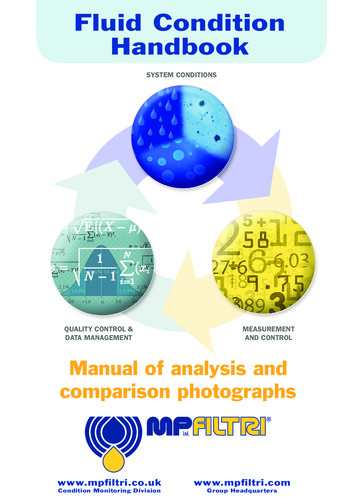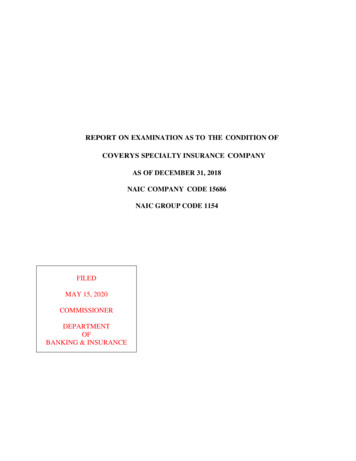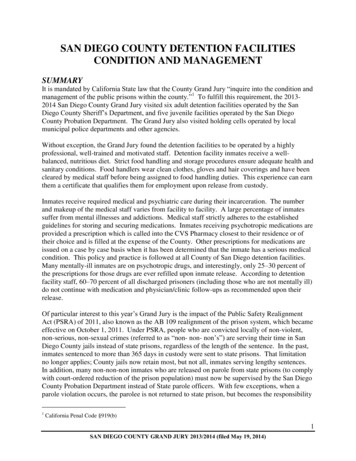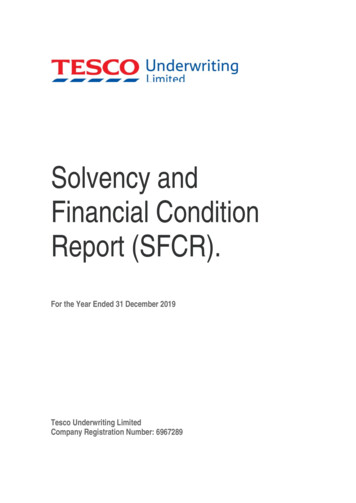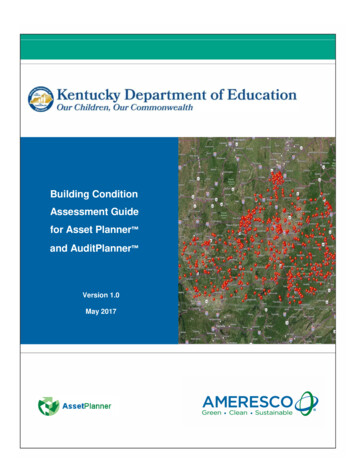
Transcription
Building ConditionAssessment Guidefor Asset Planner and AuditPlanner Version 1.0May 2017
Kentucky Department of EducationBuilding Condition Assessment Guide forAssetPlanner & AuditPlanner T ABLE OF C ONTENTS1. Introduction. 22. During the On-site Assessment . 22.1 Assessment Reminders . 32.2 Assessment On-Site Interview Questions . 32.3 Assessment Cost Guidelines . 42.4 Completing the fields in AuditPlanner . 42.4.1 Facility-Level Entries . 52.4.2 Element-Level Entries . 62.4.3 Action-Level Entries . 93. After the On-site Assessment . 133.1 Uploading from AuditPlanner . 13Appendix A: AuditPlanner Back-up Guide . 14Appendix B: FAQs for Elements . 17Appendix C: Additional Assessment Reminders . 19Appendix D: Study and End of Life Matrix . 20Appendix E: Guide for the installation of AuditPlanner 21Appendix F: Uniformat II for Building Elements (E1557) . 27Appendix G: Facility Condition Index (FCI). 28“Page content is subject to Confidentiality Restrictions”Kentucky Department of EducationBuilding Condition Assessment Guide for AssetPlanner & AuditPlanner Page 1
Kentucky Department of EducationBuilding Condition Assessment Guide forAssetPlanner & AuditPlanner 1. IntroductionThe Kentucky Department of Education utilizes Ameresco’s AssetPlanner software to identify andprioritize capital renewal needs, develop capital plans, demonstrate the funding requirements and measure theimpact of capital investments. Kentucky Department of Education also utilizes AssetPlanner to calculateand report on the Facility Condition Index (FCI) of their Portfolio. Confidence in the data that resides inAssetPlanner is critical to ensuring: The funding requirements of the Portfolio can be reviewed in parallel with other organizationalpriorities;The annual capital planning process appropriately allocates the limited funding to projects with thehighest need; andThe process used to calculate the FCI value is in line with established best practicesThis confidence is achieved by establishing and consistently applying best practices-derived processes in datadevelopment and management. The work of the Assessor in validating renewal needs during the on-siteassessment is a key component of the school ranking reports. Integrity of the data collection and reviewprocess is paramount in ensuring confidence in the results. The goal of this guide is to provide clarity toAssessors on the Building Condition Assessment process and their role in ensuring confidence in the results.2. During the On-site AssessmentThe Kentucky Department of Education utilizes Ameresco’s Data Development process (outlined in Figure 1below) to capture and maintain capital renewal needs for the buildings within AssetPlanner .Figure 1: Data Development ProcessThis process begins with the creation of a “model” life cycle cost template. Using some basic asset detailsprovided by the Kentucky Department of Education (age, size, # floors, building type), Ameresco developslife cycle cost models for each building. The models contain a listing of building element inventory based onthe various asset “types” (e.g. Elementary School, Middle School, High School etc.) and established order ofmagnitude replacement costs and renewal timelines for each major building system and element. Each modelincludes architectural, mechanical, and electrical components and systems as well as site elements.“Page content is subject to Confidentiality Restrictions”Building Condition Assessment Guide for AssetPlanner & AuditPlanner Kentucky Department of EducationPage 2
Kentucky Department of EducationBuilding Condition Assessment Guide forAssetPlanner & AuditPlanner AssetPlanner follows the ASTM Uniformat II Classification for Building Elements (E1557) - please refer toAppendix G for more information.The second step is to “validate” the life cycle cost template through a visual, non-intrusive on-site assessment.The purpose of this assessment is to provide a visual assessment to understand the actual materials and assetson the building and the visual appearance of serviceability. This is undertaken by downloading the existinginformation from AssetPlanner to AuditPlanner for site assessment. The software refers to this processas an “Audit”.2.1 Assessment RemindersBefore commencing, ensure you have permission to contact the site and arrange for access. It is recommendedthat Assessors review and become familiar with this entire guide. Ensure that: You have a valid and functioning AssetPlanner login;You have been assigned the Audit;The Audit listing contains the correct buildings/sites;You are familiar with the ASTM Uniformat II Classification system and hierarchy (please refer toAppendix G)You know and understand the recommended Best Practice surrounding back-up of AuditPlanner data (please refer to Appendix A – AuditPlanner Back-up Guide); and2.2 Assessment On-Site Interview QuestionsIt is recommended that the auditor conducts a brief interview while on site with the site contact to determineadditional information relating to the building, recent renovations or issues. Below is a sample questionnairethat you can use on-site or send out in advance of the site assessment: Facility DetailsoCan you confirm the age of the facility? (e.g.: “My report says 1990 but it looks much oldercan you confirm?”)oDoes the facility have any additions or have there been any comprehensive renovationprojects?Issues/ConcernsoAre there any current or ongoing problems at the facility that we should know about (e.g.:leaks, temperature issues, mechanical/electrical problems, etc.)?oIs there anything that you are unsure of and would like us to take a closer look at during oursite assessment?Planned WorkoHave there been any recent major replacement or repair projects that have taken place at thisfacility?“Page content is subject to Confidentiality Restrictions”Kentucky Department of EducationBuilding Condition Assessment Guide for AssetPlanner & AuditPlanner Page 3
Kentucky Department of EducationBuilding Condition Assessment Guide forAssetPlanner & AuditPlanner oHave there been any engineering studies/reports or building condition assessments over thelast 5 years?oAre there any upcoming major replacement or repair projects? (e.g.: planned projects orquotes for work, etc.)oIs there a capital plan or list of projects that is available electronically (e.g.: excel, word, pdfetc.)?This short questionnaire should help to fill in the blanks when it comes to unknown items such as concealedsystems or the specific year that elements were recently replaced (last major action year). It will also help toidentify areas of concern or ongoing issues that can be investigated further during your site review anddocumented as part of your report.2.3 Assessment Cost GuidelinesWhen preparing cost estimates for your building condition assessment reports it is important to keep in mindthe following: Pre-loaded cost values come from the model templates and reflect general assumptions based on basicasset details (refer to Figure 1: Data Development Process above). The model values are providedfor reference purposes only. It is expected that the assessor will update all cost values based ontheir own experience and professional opinion. Cost estimates should be consistent across all reports for same elements and actions. For example,windows of roughly the same size and specification should carry the same replacement and action costestimate across all facilities being assessed that have these same windows. If there are differencesleading to differing cost estimates, please note them in the Element or Action commentary columns.Cost Estimates for all elements are to be calculated based on the quantity/actual area of the element.2.4 Completing the fields in AuditPlanner It is to be expected that you will come across building elements where the true condition is not evident due tothe visual, non-intrusive nature of the AuditPlanner site assessment. For cases where these elements haveexceeded their estimated useful lives or there is a known issue with the element, a “Study” Action will have tobe recorded to determine the exact conditions (as well as second “Replacement” Action). Please refer to theAppendix D - Study and End of Life Matrix for additional guidance.Element & Action Consistency: Ensure that the recommended “Action Year” matches the timelines associated with your selections inthe “Overall Condition” and “Urgency of Action” fields.o For Example: If a Replacement Action exists within the first 1-3 years the “OverallCondition” should not be “Good” and the “Urgency of Action” should not be “Low”.Ensure that the “Replacement Value” of an Element matches the “Replacement Action” cost.“Page content is subject to Confidentiality Restrictions”Building Condition Assessment Guide for AssetPlanner & AuditPlanner Kentucky Department of EducationPage 4
Kentucky Department of EducationBuilding Condition Assessment Guide forAssetPlanner & AuditPlanner If a “Repair” or “Study” Action is suggested, always ensure that a “Replacement” action (cost/year) isalso included and include a note in that Action to refer to the Study Action for more details. In general, all Elements should include an End of Life, full Replacement Action, with the exception ofelement A10/A20 Foundations and element B10 Superstructure. These systems are typically notforecasted for replacement but may require repairs if a deficiency is evident or noted by site staff.2.4.1 Facility-Level EntriesUpon downloading each audit will contain basic facility level information such as Construction Year, Size,Number of Floors and Units. The information provided is a starting point for the audit and must be reviewedand corrected if necessary based on site observations. In addition to making corrections to the base details theauditor must fill out a building description and the associated Audit summary fields (General, Architectural,Mechanical, Electrical). The auditor must also take a representative photo of the facility as well as anydifferent elevations or differences in the structure.Audit:Audit # and Summary This field is not editable.Name of Facility:The KDE Facility name. This field is not editable.Address:This field is for the full street address only (no city or state). Do not use abbreviations(e.g.: Dr for Drive, Ave for Avenue, St for Street, etc.) as the system uses this addressfor GIS mapping. Correct it if it is incorrect.Construction Year:Year the building was constructed. Assessors are responsible for confirming theconstruction date. Correct as necessary.If the original size provided is incorrect please update it accordingly:Size of Facility:For Facility Assets assessors are responsible for confirming the number of heated squarefeet of building space, accurate to /- 7% for each building being assessed.For Site Assets please review the size and update according to the full site area, which isto include the building footprint.Floors AboveGround:Number of floors above ground, including the ground floor.For Facility Assets enter a brief description or summary of the building including itemssuch as any additions with different construction years than the original, unusualconstruction types or other features (such as heritage status), and if applicable anydifferences noted in Facility Name.Description:e.g.: “Smallville Elementary School is a 1-storey school built in 1968. The gymnasium was added to therear of the building in 1997”For Site Assets enter a brief summary of the site including any significant site featurese.g.: “Smallville Elementary School is situated on a rural site covering 5 acres and includes 55 parkingspaces, a playground and chain-link perimeter fencing.”General Summary:Provide a general summary of the audit results. Note the general condition of the facility,any modernizations and a brief summary of any major concerns. Any specific notes from“Page content is subject to Confidentiality Restrictions”Kentucky Department of EducationBuilding Condition Assessment Guide for AssetPlanner & AuditPlanner Page 5
Kentucky Department of EducationBuilding Condition Assessment Guide forAssetPlanner & AuditPlanner the onsite assessment can be included in this section (e.g. “Unable to access the roof due tolack of roof hatch key during assessment.”).e.g.: “The roof was reported to have been replaced in 2006 and was reported to be in good condition. Theexternal walls, majority of windows and the doors were reported to have been replaced in 2006 and theywere observed to be in good condition. The windows at the back of the building are the older steel framedsingle glazed windows and they were observed to be in poor condition. The domestic hot water heaters in themechanical room are in good condition and should be considered for replacement within approximately sixyears.”Provide a general summary of the Architectural systems. Note the general condition of thearchitectural systems, any modernizations and a brief summary of any major concerns.ArchitecturalSummary:e.g.: “The exterior walls of the building are mainly clad with stucco, along with a portion of Fiber Cementsiding at the building rear on the ground level . The walls were observed to be in good condition. Painting isrequired in the short term. The windows are a combination of newer, double-glazed, vinyl-framed units andolder, steel-framed units. The vinyl-framed units were observed to be in good condition. The older, steelframed units require replacing in the short term. The roof consists of two-ply SBS bitumen membrane andsloped roofing with asphalt shingles on the gazebo. The Interior finishes include carpet and vinyl flooringthroughout the building, drywall partitions and ceilings, and ceramic tiles in the bathrooms.”Provide a general summary of the Mechanical systems. Note the general condition of themechanical systems, any modernizations and a brief summary of any major concerns.MechanicalSummary:e.g.: “There are two domestic hot water heaters in the mechanical room on the main floor. These werereported to have been installed in 2008 and are in good condition. The classrooms are heated by electricbaseboard heaters with the common hallways served by two roof-top packaged units. The baseboards,installed in 2008, and the roof top units, installed in 1998, were observed and reported to be in goodcondition. Plumbing fixtures appear to be in working order, however some consideration for waterconservation should be reviewed. Fire protection is provided by a sprinkler system and fire extinguishersthroughout the remainder of the building.”Provide a general summary of the Electrical systems. Note the general condition of theelectrical systems, any modernizations and a brief summary of any major concerns.Electrical Summary:e.g.: “The building is provided with a 400 amp service and distributed to circuit breaker panels. Electricalpanel boards and branch wiring appear to be from the buildings renovation in 2006. These systems are ingood condition. We recommend infrared testing in order to ensure safe and efficient operations. The interiorlighting varies with linear, compact fluorescent and some incandescent fixtures. The majority of incandescentand fluorescent lighting fixtures were reported to have been installed in 2006 and are in good condition.Other electrical components include exit and emergency lights and fire alarm system, which are all in goodcondition.”2.4.2 Element-Level EntriesThe goal of reviewing elements onsite is to provide a general summary of the current element condition,including actions required by the elements to maintain them in good working order for the long term. Thisinformation will be used to plan and prioritize capital renewal projects, so it is important that your informationentries (and associated photographs) establish a clear picture of onsite conditions and required actions toenable planners and decision makers to appropriately respond. Ensure you take a photograph of anynameplates of building systems equipment and utility meters. When possible make sure that the model andserial numbers are legible in the photograph.“Page content is subject to Confidentiality Restrictions”Building Condition Assessment Guide for AssetPlanner & AuditPlanner Kentucky Department of EducationPage 6
Kentucky Department of EducationBuilding Condition Assessment Guide forAssetPlanner & AuditPlanner When to create multiple Elements?Create multiple Elements, using the “Add” button from the Element screen, whenever you are dealing withone or more of the following: Differing Age, Differing Condition, or Differing Types of Elements.Generally speaking if the Cost or Lifecycle of any items are different, then they must be represented as theirown Elements.For example, a building may have a single roofing type, but a portion was replaced with the remainder beingthe original installation. These two portions should be entered as separate elements, with their different “LastMajor Action Year”. In this example, you should ensure that the recently replaced portion is intended to last atypical full lifecycle and NOT be replaced with the remaining portion. If it is intended to be replaced with theremaining portion there is no need to create a separate element, just note this in both the Element and ActionCommentaries.Examples:Differing Types (with different life cycles): Modified Bitumen SBS vs Built-Up Roof (BUR) built up roofing sections Brick exterior walls and stucco exterior walls.Differing Age: Flat roof sections installed in different years Boilers installed in different yearsDiffering Condition: Two roof sections installed in the same year, one in poor condition and one in good condition.Building Sections/Additions:Schools that have additions or building sections is another scenario that requires the creation of multipleelements. If the School you are inspecting contains multiple additions or sections you will need to identify theelements that belong to each section. For example, if you have a building with 2 sections (1975, and 2001) youwill need to build your inventory list using the ‘Section’ field on the element page to differentiate betweenelements that are associated with the 1975, 1985 and 2001 sections.Some examples: Element #1, B30 Roofing, Section: 1975 Addition, Description: Built-Up Roof, Condition: PoorElement #2, B30 Roofing, Section: 2001 Addition, Description: 2 Ply SBS, Condition: GoodElement #1, C3020 Floor Finishes, Section: 1975 Addition, Description: VCT, Condition: PoorElement #2, C3020 Floor Finishes, Section: 2001 Addition, Description: VCT, Condition: GoodNote: Where items are “common” to all sections you would leave the section field blank which indicates thatthe system is shared or of a similar type/age/condition across all building sections. An example of this may bea centralized cooling/heating system that serves both sections.“Page content is subject to Confidentiality Restrictions”Kentucky Department of EducationBuilding Condition Assessment Guide for AssetPlanner & AuditPlanner Page 7
Kentucky Department of EducationBuilding Condition Assessment Guide forAssetPlanner & AuditPlanner Deleting ElementsEnsure that you use the “Delete” button from the Element screen to remove an element. Do not note it asno longer present in the description.Element Level Fields:Element:UNIFORMAT II category name is not editableElement Number:Not editable. This refers to the number of categories and not the quantity of the element.Last Major ActionYear:Enter the year that the element was last replaced. In the case of Foundations, ExteriorWalls or other systems that are typically not replaced you can use this field to indicate theyear in which a major refurbishment took place.Identify the overall condition of the entire element. The year ranges listed below relate tothe Actions associated to the Element. Refer to “When to create multiple Elements?”above for additional guidance.Overall ConditionGoodElement is performing adequately and no work is foreseen in the next 5 yearsFairElement is operational but replacement or major repair action is expected in3-5 yearsPoorElement requires replacement or major repair action in next 1-3 yearsCriticalElement is past the point of economic repair or is not functioning andshould be replaced or repaired within 1 yearReplacement Cost:The replacement cost field should capture the total value of the element. Be sure that thisvalue matches up with any associated “Replacement” actions.Section:Specify the building section or addition that the element belongs to using the available dropdown values (e.g. 1975 Addition, 1985 Addition, 2001 Addition) Refer to “When to createmultiple Elements?” for additional guidance.Location:This field is used to describe the exact location of specific items within the building wherefurther clarity is required (e.g. Maintenance Room 2, First Floor Corridor, etc.)ElementDescription:The element description should be utilized to provide a brief description which mustinclude: general description of overall system, type, size, make, model, serial, quantity.e.g. “Two Boiler Brand, 1,500,000 BTU, gas fired, mid-efficiency 85% boilers model BOIL-85, serial noXX##### (boiler 1 - Mechanical) and serial no XX##### (boiler 2) installed in 1985”“Domestic Water Distribution – copper mains, PEX distribution to classrooms”Commentary:Enter a description for the element detailing any additional information relating to itscondition and any on-site observations. If no pertinent additional information is present,field can be left blank.“Page content is subject to Confidentiality Restrictions”Building Condition Assessment Guide for AssetPlanner & AuditPlanner Kentucky Department of EducationPage 8
Kentucky Department of EducationBuilding Condition Assessment Guide forAssetPlanner & AuditPlanner e.g. “Listed as Fair Condition due to the major repair required on the South Elevation due to observedsignificant moisture ingress, otherwise remaining three elevations are in Good Condition.”For Category B- Shell elements, please include the quantity (or an estimate if the quantity isnot available). Examples include: Validated (Y/N):“12,500 sq. ft. of Modified SBS roof”“estimated 120 windows”“40% of wall area is cladded with brick veneer”This field has no impact on the data – it is entirely for the auditor’s personal use to keeptrack of Elements reviewed while on site. It does not need to be utilized.2.4.3 Action-Level EntriesThe goal of reviewing Actions onsite is to provide a general summary of the Action required by elements tomaintain them in good working order for the long term. This information will be used to plan and prioritizecapital renewal projects, so it is important that your information entries (and associated photographs) establisha clear picture of onsite conditions and required actions to enable planners and decision makers toappropriately respond. Ensure that you take photographs of deficiencies noted in the action items atthe element level, especially for actions required within the next five years.When to create multiple Actions?Create multiple actions for different action types (repair, replace, install, study). Remember if you arecreating a repair or study action you must add another action to represent the full replacement value andforecasted year. Do not create multiple actions to represent phasing, allowances or for other budgetaryconcerns. The purpose of the capital plan is to identify building needs and present an accurate picture ofcondition, budgets and allowances can then be developed based on the findings. If you phase or includebudget allocations this will understate the capital need and the capital plan will be inaccurate.For Actions: Verify that Actions exist in appropriate years based on observed conditions (not based on budgetaryconcerns). If the scheduled Action Year is incorrect please adjust the year according to observed site conditions.This should align with your entry for “Overall Condition”. Verify that Action Costs are appropriate based on recommended action. DO NOT include allowances or maintenance items (e.g. replace door handle on Classroom 121 orallowance for replacement of one door every year) Ensure that an Action Brief Description has been entered (e.g. Replace Boiler.) Where applicable include a justification or further detail about the action in the Action Commentary(e.g. we recommend replacing the boiler with an energy efficient model.) Ensure that Priority Answers have been selected. Assign “Low Urgency” and/or “Overall Condition: Good” Action items over multiple future years:do not assign all these items to one future year as this has an unintended, adverse effect on FCI.“Page content is subject to Confidentiality Restrictions”Kentucky Department of EducationBuilding Condition Assessment Guide for AssetPlanner & AuditPlanner Page 9
Kentucky Department of EducationBuilding Condition Assessment Guide forAssetPlanner & AuditPlanner Action Level Fields:Action Number:This refers to the number of action types per component. Not editableAction Cost:The cost to perform the action in current year dollars, including removal, disposal andreplacement. Do not include allowances – this should represent the full replacement.Action Year:The year that the action is to be conducted.Repeat Interval(years):The Lifecycle of the element. The template will generate a general assumption of how longa typical element will last. In most cases this will not require modification however it isexpected that the auditor will adjust the Repeat Interval based on observedsystem(s) onsite.Action Type:Life Safety / CodeRelated?Adverse Effect onSecurity?ReplacementElement is at the end of economic life and should be replacedRepairElement can be repaired and its life extended. Remember to alsoinclude the associated “Replacement” action item.InstallElement that didn’t exist before and is planned to be installed.StudyA deficiency exists (or is likely to exist) and a study should becommissioned to determine scope of work and cost. Refer toAppendix D - Study and End of Life Matrix for additionalguidance. Remember to also include the associated“Replacement” action item.Life Safety or Code issues that require Immediate Attention should be brought tothe attention of the building operator and the Kentucky Department of Education.If code issues are apparent, noted or observed select the appropriate item below. Forcertain elements that have reached their estimated useful lives or show deficiencies thatcould cause a safety risk (e.g. old wiring, corroded gas piping, etc.), the “Safety Risk” dropdown should be selected. Tripping hazards, loose handrails, visible mold, asbestos (friable,non-encapsulated) damaged stairs, etc.) should also be considered as “Safety Risks”. Abrief description of the safety risk should be included and a picture. The action should be“Urgent” and in the current year.NoThe action is not related to code / life safetyGrandfatheredCode IssueThe action will need to comply with current code if it were to bereplaced or repaired.ImmediateCode IssueThe action is immediately required to comply with applicable code.Safety RiskThe action will help avert serious injuries or health deterioration.All security issue should be brought to the attention of the building operator andthe Kentucky Department of Education as soon as they are discovered. Examples ofSecurity-related issues include: doors that do not close properly, damaged door hardware,poorly lit building and site areas, lack of cameras or security monitoring equipment, etc.NoDeferring this action will not impact building security.“Page content is subject to Confidentiality Restrictions”Building Condition Assessment Guide for AssetPlanner & AuditPlanner Kentucky Department of EducationPage 10
Kentucky Department of EducationBuilding Condition Assessment Guide forAssetPlanner & AuditPlanner Action is required to address noted security issues. Deferring thisaction will have an impact on building security.YesExamples of Elements that could potentially or partially shut down a building includeactive roof leaks, non-redundant heating plant, electrical switchgear and panelboards andfailed fire alarm systems.Risk of buildingshut down?NoFailure of this element will not cause a building shut down.PartialFailure of this element will cause a partial building shut down.FullFailure of this element will cause a building shut down.Building condition assessments are not generally detailed accessibility reviews. However, ifyou notice an accessibility issue, concern, or need for improvements please select theappropriate response below. Specify the issue or requirement within the commentary field.AccessibilityRelated?NoThis action is not related or will have no impact on buildingaccessibility.YesThis action is required to address an accessibility issue, concern orrequirement.Will this Action to the Element result in operational savings (less maintenance ormaintenance calls, avoid unplanned repairs) or result in energy savings (new, efficientelement or improve the overall energy use of the building)? This field is often used to filterfor energy-use reduction measures.N/AOperation / EnergySavingsIf deferred,operating costsincreaseModerat
AssetPlanner follows th e ASTM Uniformat II Classification for Building Elements (E1557) - please refer to Appendix G for more information. The second step is to “validate” the life cycle cost tem
